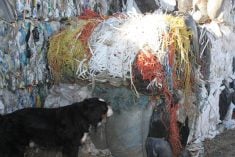Action must be taken to ease what is becoming a critical shortage of veterinarians in Alberta, says one of the leaders of the province’s beef industry.
“It’s just really reached a peak right now where the access to veterinarians, especially in more remote rural areas, is starting to become what I believe is an animal welfare issue,” said Melanie Wowk, chair of the Alberta Beef Producers.
Besides the financial loss caused by the preventable illness or death of valuable livestock, it is taking an emotional toll on farmers and ranchers who are unable to get help for their animals, she said. “I think sometimes it ends up in people getting their neighbours or friends to do things for them that they’re not trained to do… but I think out of desperation, it’s just done.”
Read Also

Message to provincial agriculture ministers: focus on international trade
International trade stakeholders said securing markets in the face of increasing protectionism should be the key priority for Canada’s agriculture ministers.
The shortage not only affects livestock sectors in Alberta ranging from beef, chicken and pork to sheep and goats, it also extends to other provinces across Canada, she added.
Although none of the provincial beef producer commissions have officially asked the Canadian Cattlemen’s Association about the problem, president Bob Lowe has heard anecdotally about the situation. It is likely widespread enough to be a national issue, he added.
Wowk said Alberta Agriculture Minister Nate Horner has stated he will be making an announcement to address the problem. He discussed the issue during an ABP meeting Feb. 8 in Brooks, Alta.
An email from the Western Producer for more details was not returned by Mackenzie Blyth, press secretary for Horner.
The Ontario and federal governments announced Jan. 19 they will provide up to $4 million to boost veterinary services in that province.
“The Livestock Veterinary Innovation Initiative is a new, cost-share program that will increase the access options for veterinary care, especially in rural and northern Ontario, to better support animal health, the livestock agri-food sector and the strength of the province’s food supply,” said a statement.
It will boost options such as telemedicine and virtual or online care by providing financial support for things such as special equipment and training for veterinarians. The initiative will also address the challenges facing mobile clinics, “such as long distances between farmers and animal health care providers, and the shortage of food-animal veterinarians working in underserviced areas.”
It will be funded through the federal-provincial Canadian Agricultural Partnership. Successful applicants will be compensated for up to 35 percent of eligible expenses for Ontario as a whole, and to a maximum of 50 percent in areas identified as underserviced.
Wowk said another potential solution for Alberta is to increase the role of animal health technologists, allowing them to provide services such as vaccinations or pregnancy diagnosis that may not require veterinarians.
Technologists only need two years of training at the college level to get a diploma, much less than what it takes for university students to earn their doctor of veterinary medicine degrees, she added.
The reasons behind the veterinarian shortage are partly similar to Alberta’s difficulty attracting enough physicians to look after rural residents, she said. “I think it’s a little bit generational and that (new veterinarians) expect to have a better quality of life than perhaps some older veterinarians expected when they went in.”
Besides long hours, often being on call and having to travel extensive distances, dealing with large, strong animals such as cattle and horses that can kick or bite you can be physically demanding, said Wowk, who is a veterinarian as well as a beef producer.
“I’ve had a toe fused to my foot. I’m waiting for the other ones to be fused … I’m waiting for a knee replacement.”
As a result, Wowk no longer works directly with animals and is instead employed by the pharmaceutical industry. “And I remember people saying to me, ‘Oh, you know, you might be doing this when you’re 50.’ And I thought, ‘Oh, no problem.’ And I’m 55, and no, I can’t do it anymore.”
An emotionally draining part of the job involves euthanizing animals, adding to the burden on veterinarians’ mental health, she said. “Veterinarians are now the number-one profession for suicide rates.”
Veterinary students in Alberta currently consist of about 85 to 90 percent women, up from about 40 percent in the early 1990s, she said. “We’re the ones that if we decide to have children (after graduating) … there’s some time taken out there. Some return, some don’t.”
The average veterinarian in Alberta makes about $90,000 per year, “so for eight years of schooling and the type of work you’re doing, it’s really peanuts compared to doctors or lawyers or dentists …
“And you come out of school being $100,000 in debt, and you’re only making that kind of money and you’re trying to buy a house, you’re trying to start a family, buying a vehicle, and it’s just not feasible for a lot of people.”
Earning a doctor of veterinary medicine degree can open the door to other kinds of work in the pharmaceutical industry or government, said Wowk. “A lot of people go on and get their masters and their PhDs in other areas and (do) not practice, so we’re also losing them there.”
The other problem is the shortage is worldwide, “so we used to talk a lot about bringing foreign veterinarians in — well, those countries don’t want to lose them, either, so it’s happening not only here but everywhere else, and the U.S. as well is going through the same thing.”
Contact doug.ferguson@producer.com
















